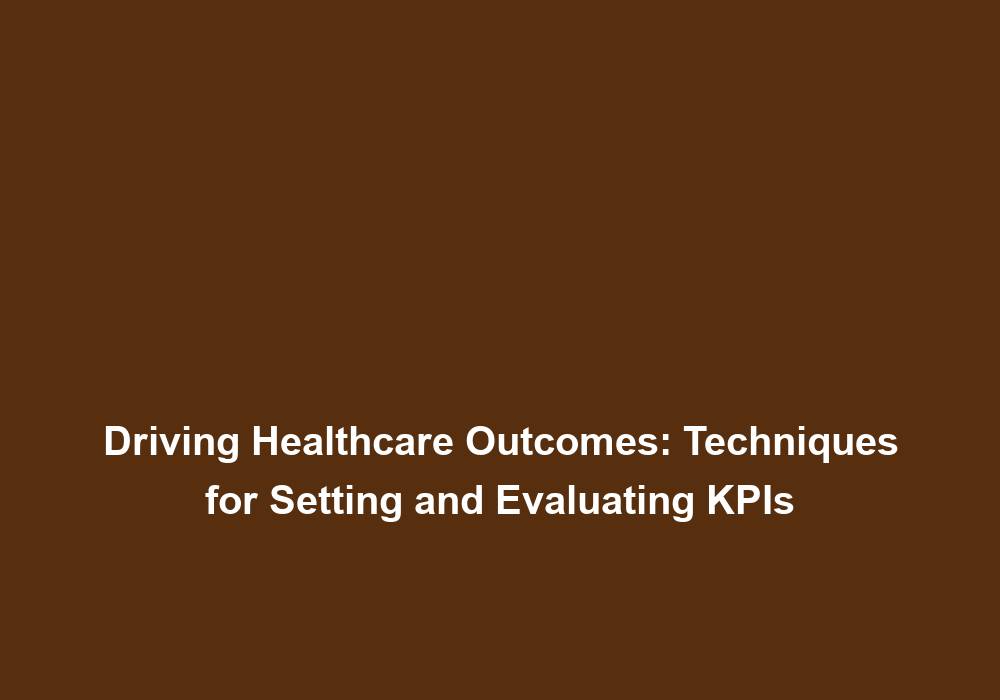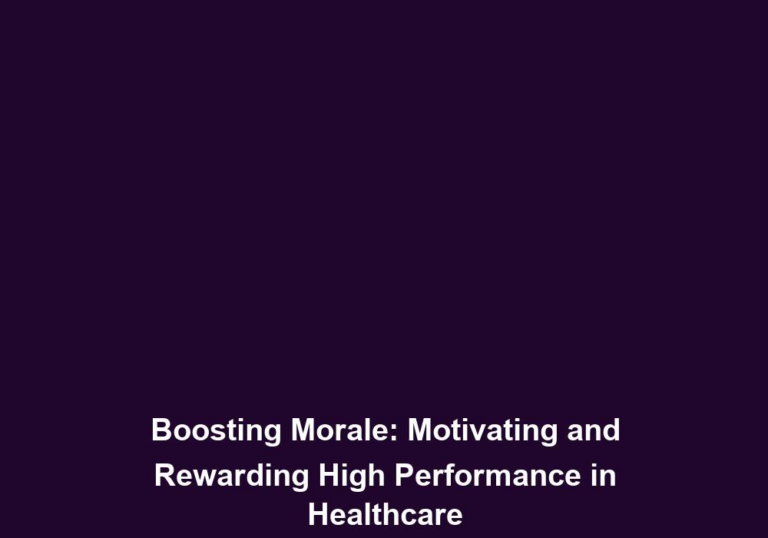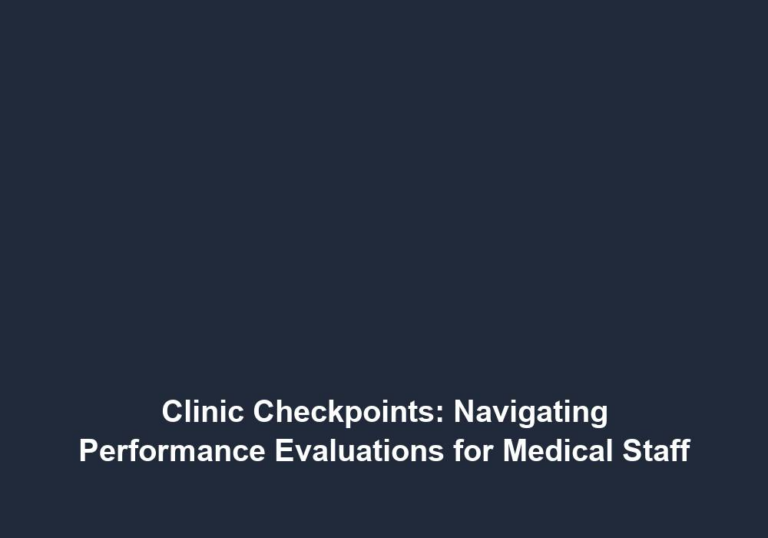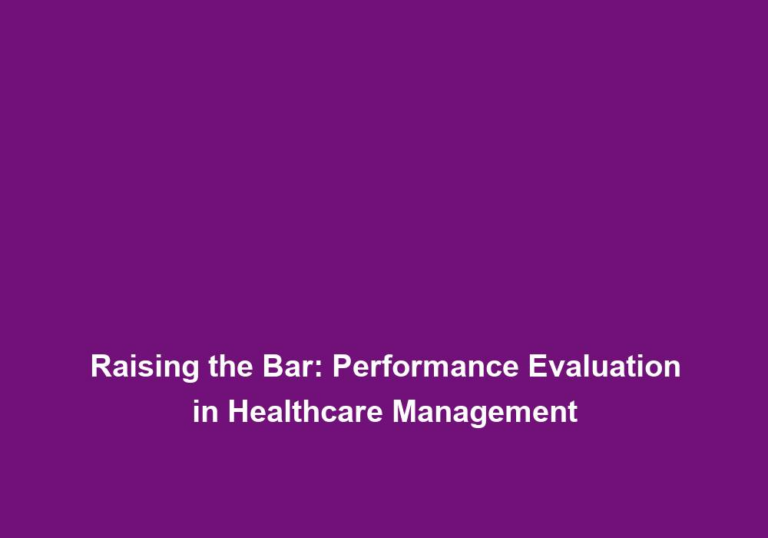Driving Healthcare Outcomes: Techniques for Setting and Evaluating KPIs
Key Performance Indicators (KPIs) play a critical role in the healthcare industry, providing valuable insights into measuring and improving performance. By setting and evaluating KPIs effectively, healthcare organizations can drive better outcomes, enhance patient care, and optimize operational efficiency. In this article, we will explore various techniques for setting and evaluating KPIs in the healthcare sector.
Importance of KPIs in Healthcare
KPIs serve as essential tools for healthcare organizations to monitor and assess their performance across different areas, such as patient satisfaction, clinical outcomes, operational efficiency, financial management, and more. These metrics provide a clear and measurable way to evaluate progress and identify areas that require improvement.
By focusing on the right KPIs, healthcare providers can enhance their decision-making processes, drive positive change, and ultimately deliver better care to patients. For example, by monitoring patient satisfaction metrics, healthcare organizations can identify areas where patient experience can be improved, such as reducing wait times or improving communication between healthcare providers and patients.
Additionally, KPIs related to clinical outcomes, such as infection rates or medication errors, can help healthcare organizations identify systemic issues and implement strategies to improve patient safety. By tracking and evaluating these metrics, healthcare providers can proactively address potential risks and ensure the delivery of high-quality care.
Operational efficiency is another critical area where KPIs can drive significant improvements. By monitoring metrics related to resource utilization, such as bed turnover time or staff productivity, healthcare organizations can identify bottlenecks and implement process improvements to optimize resource allocation and reduce costs.
Financial management is also a key aspect of healthcare operations, and KPIs related to revenue generation, cost control, and profitability can help organizations make informed financial decisions. By monitoring metrics such as revenue per patient or cost per procedure, healthcare organizations can identify opportunities to maximize revenue and reduce costs, ultimately improving their financial sustainability.
Techniques for Setting Effective KPIs
-
Identify Strategic Goals: To set effective KPIs, it is crucial to begin by defining the strategic goals of your healthcare organization. These goals may include improving patient safety, reducing readmission rates, streamlining processes, increasing revenue, or enhancing patient satisfaction. By aligning your KPIs with these goals, you ensure that they are directly linked to the overall success of your organization.
-
Select Relevant Metrics: Once the strategic goals are established, identify the key metrics that will help you measure progress towards those goals. For example, if improving patient safety is a priority, you might track metrics such as medication errors, infection rates, or patient falls. Ensure that the metrics you choose are meaningful, quantifiable, and aligned with the specific goals you want to achieve.
-
Involve Stakeholders: It is crucial to involve stakeholders from various departments within your healthcare organization when setting KPIs. This collaborative approach ensures that all perspectives are considered, and the KPIs are relevant and meaningful to the entire organization. By involving frontline staff, clinicians, administrators, and executives, you can foster a sense of ownership and accountability towards achieving the desired outcomes.
By involving frontline staff, you gain insights into the daily challenges they face, enabling you to set realistic and actionable KPIs. Clinicians can provide valuable input on clinical outcomes and patient care metrics, ensuring that the KPIs reflect the quality of care delivered. Administrators can contribute their expertise in operational efficiency, financial management, and resource allocation, ensuring that the KPIs align with organizational priorities.
- Set Realistic Targets: When setting KPIs, it is important to establish realistic targets that are achievable within a specific timeframe. Unrealistic or unattainable targets can demotivate staff and hinder progress. Consider historical data, industry benchmarks, and expert opinions to set targets that are challenging yet attainable. Regularly review and update targets as necessary to reflect changing circumstances and evolving goals.
Setting realistic targets allows healthcare organizations to track progress effectively and identify areas where improvements are needed. It also provides a benchmark for evaluating performance and enables organizations to celebrate successes when targets are met or exceeded.
- Ensure Measurability and Data Availability: Before finalizing your KPIs, ensure that the necessary data can be collected, measured, and reported accurately. Collaborate with your IT department to assess data availability, integrity, and reporting capabilities. Implement systems and processes that enable the collection of relevant data in a consistent and timely manner. Without accurate and reliable data, evaluating KPIs becomes challenging and may result in ineffective decision-making.
By ensuring measurability and data availability, healthcare organizations can rely on accurate information to evaluate their performance and make informed decisions. This requires implementing robust data collection systems and ensuring data quality through regular validation and audits. It also involves leveraging technology solutions, such as electronic health records and data analytics tools, to streamline data collection and analysis processes.
Techniques for Evaluating KPIs
Once KPIs are set, it is important to regularly evaluate and monitor progress to drive continuous improvement. Here are some techniques for effectively evaluating KPIs in the healthcare industry:
- Data Analysis and Reporting: Analyze the data collected from various sources to evaluate the performance of your KPIs. Utilize data visualization techniques such as charts, graphs, and dashboards to present the information in a clear and concise manner. Regularly generate reports and share them with relevant stakeholders to facilitate data-driven decision-making.
Data analysis and reporting provide insights into the performance of KPIs, enabling healthcare organizations to identify trends, patterns, and areas for improvement. By visualizing the data, stakeholders can quickly grasp the key takeaways and make informed decisions to drive positive change.
- Benchmarking: Compare your organization’s performance against industry standards and best practices to assess how well you are doing. Benchmarking allows you to identify areas of improvement and learn from high-performing organizations. Collaborate with industry associations, participate in benchmarking studies, and leverage external resources to gain insights into best practices and identify strategies for enhancing performance.
Benchmarking provides a valuable perspective on KPI performance, enabling healthcare organizations to identify areas where they are lagging behind and opportunities for improvement. By learning from others who have achieved success in similar areas, organizations can implement proven strategies and tactics to drive better outcomes.
- Continuous Feedback and Review: Establish a feedback loop to collect input from various stakeholders on the effectiveness of your KPIs. Regularly review and refine your KPIs based on feedback and changing organizational priorities. Engage in discussions with frontline staff, clinicians, and administrators to gain valuable insights and make informed adjustments to your KPIs when necessary.
Continuous feedback and review ensure that KPIs remain relevant and aligned with the evolving needs and priorities of the healthcare organization. By actively seeking input from stakeholders, organizations can identify areas for improvement, address challenges, and make necessary adjustments to optimize performance.
- Regular Performance Meetings: Conduct regular performance meetings with relevant stakeholders to discuss the progress of KPIs, identify any challenges, and brainstorm potential solutions. These meetings provide an opportunity for collaboration, accountability, and continuous improvement. Encourage open and honest dialogue, and ensure that action plans are developed to address any performance gaps identified.
Regular performance meetings foster a culture of transparency, collaboration, and accountability within healthcare organizations. By discussing KPI performance, organizations can identify areas of success, address challenges, and develop action plans to drive continuous improvement.
- Celebrate Success and Learn from Failures: Recognize and celebrate achievements when KPIs are met or exceeded. This helps to motivate and inspire staff to continue striving for excellence. Similarly, when KPIs are not met, view them as learning opportunities rather than failures. Conduct root cause analyses, identify reasons for underperformance, and implement corrective actions to ensure continuous improvement.
Celebrating success and learning from failures are essential components of a culture of continuous improvement. By recognizing achievements, healthcare organizations can motivate their staff and reinforce the importance of KPIs. When KPIs are not met, organizations can use these instances as opportunities to learn, improve processes, and implement changes that drive better outcomes.
By utilizing these techniques, healthcare organizations can effectively set and evaluate KPIs, thereby driving positive outcomes and delivering high-quality care. Remember, it is essential to regularly review and update your KPIs to align with changing goals, industry trends, and organizational priorities. Continuous improvement and a data-driven approach are key to achieving success in the ever-evolving healthcare landscape.
This article is written by a SEO content writing expert with fluent English, specializing in healthcare-related topics.






